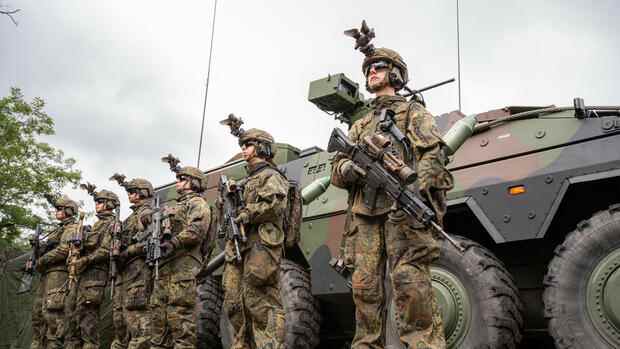In the future, the Bundeswehr will play an even greater role in securing NATO’s eastern flank.
(Photo: dpa)
Berlin Army Inspector Alfons Mais shouldn’t suffer from boredom. It not only has to enable the land forces, which have long been geared primarily to foreign missions, to fulfill their core task of national defence. The German government’s commitments to NATO must also be fulfilled.
Germany intends to expand its commitment to securing the alliance’s eastern flank. In response to the Russian annexation of Crimea, NATO is showing an “enhanced forward presence” there.
Since 2017, multinational battlegroups have been stationed in the three Baltic states and in Poland. The Bundeswehr leads the so-called Battlegroup in Lithuania, which comprises a total of around 1,000 soldiers.
Personnel and equipment rotate regularly because the Allianz had promised not to seek permanent stationing of substantial combat troops in the former Warsaw Pact countries. In the 1997 Founding Act, Russia and the NATO states regulate mutual relations, cooperation and security between the countries.
Top jobs of the day
Find the best jobs now and
be notified by email.
The NATO unit is now to be expanded to brigade strength with a total of 3,000 to 5,000 soldiers. For this purpose, additional accommodation and storage facilities for weapons and equipment must first be created in Lithuania. The Panzergrenadierbrigade 41 “Vorpommern” will take over the increased protection of the NATO partner Lithuania.
Bundeswehr provides thousands of soldiers for rapid deployment
In addition, the army is preparing for deployment as part of the rapid reaction force, the NATO Response Force (NRF). The multinational force currently comprises up to 40,000 soldiers and can be deployed in a very short time to carry out military operations.
>> Read here: Army Inspector – “We have to make sure that we don’t just buy old slow-movers now”
By 2024, the Bundeswehr will be taking part in the NRF with around 16,800 soldiers. In the coming year, it will provide around 5,000 soldiers and management personnel for the Very High Readiness Joint Task Force (VJTF).
The troops of this “spearhead” of NATO must be ready to be deployed to operational areas within 48 to 72 hours. Panzergrenadierbrigade 37 “Freistaat Sachsen” will lead the multinational land forces of the VJTF.
The alliance wants to increase its rapid reaction force to 300,000 soldiers.
(Photo: IMAGO/ZUMA Wire)
At the NATO summit at the end of June, NATO Secretary General Jens Stoltenberg announced that the Alliance’s rapid reaction force would be increased to 300,000 men and women. Federal Chancellor Olaf Scholz (SPD) has promised that Germany will participate with an armored division of the order of 15,000 soldiers, more than 60 aircraft and up to 20 naval units.
Stoltenberg would like to have the troops available by the end of 2023, in Berlin it is more likely that the end of 2024 will be available. And incidentally, the foreign missions mandated by the Bundestag, such as the one in Mali, are also continuing for the Bundeswehr, which also tie up forces and material.
Divisions must be operational quickly
The army, which with around 63,000 soldiers represents a good third of the troops in the Bundeswehr, is being restructured for the tasks to be performed. The interim goal is an operational and fully equipped division by 2025. In perspective, three army divisions are to be established over the next ten years.
In view of the new threat posed by Russia, such a division must be able to “cold start”, as the military say, i.e. in the event of a crisis it must be able to be quickly relocated to Lithuania to protect NATO’s eastern flank. This is only possible if it not only has soldiers and weapons, but also the necessary logistics, communications or air defense.
In the current structure, these forces are spread across various organizational areas of the Bundeswehr. Here it is important to establish “firm relationships between army units and supporting parts of the other military organizational areas” in order to “improve the ‘cold start capability’ and meet NATO requirements for responsiveness,” writes the Ministry of Defense in its progress report published at the beginning of July to take stock, which should be the basis for the Bundeswehr reform.
>> Read here: Return to the Cold War – NATO adopts new strategy
Various constellations are conceivable – including a return to the old structure – to place the supporting units directly under the army again. Inspector General Eberhard Zorn ruled this out, at least for the planned build-up of the first division by 2025.
More on this: Bundeswehr gets new territorial command

